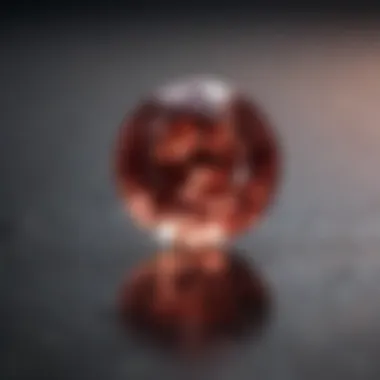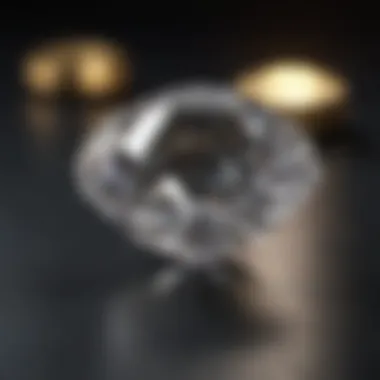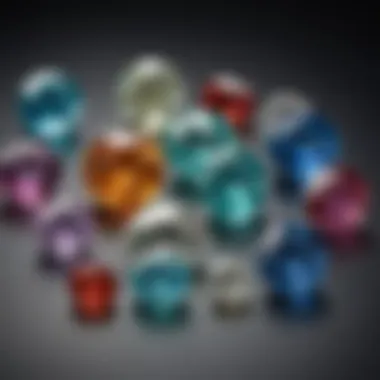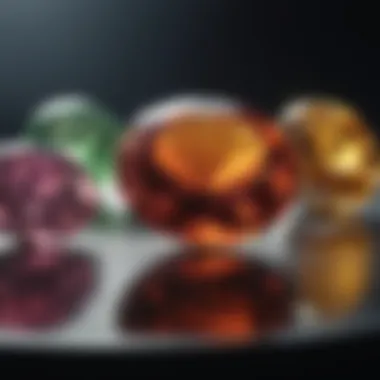Understanding Carats: 7 mm Gemstone Conversion


Intro
The conversion of gemstone size to carat weight is a fundamental concept in the world of gemstones. Understanding how a specific measurement, like 7 mm, translates into carats can significantly impact purchasing decisions for enthusiasts and collectors. This topic not only covers numerical conversions but also touches on the physical properties of gems, influencing their value, appearance, and desirability.
Gemstone Overview
Definition and Characteristics
Gemstones are naturally occurring mineral crystals prized for their beauty, rarity, and durability. Each gemstone possesses unique characteristics such as color, clarity, cut, and carat weight. Often, these features significantly affect their overall value. For example, a flawless diamond can command a premium price compared to one with visible inclusions.
The size of a gemstone, often measured in millimeters, plays a crucial role in aesthetics. A larger stone may appear more captivating, yet its value is also influenced by its weight in carats. The metric of size and carat weight can sometimes lead to misconceptions about a stone's true value and quality.
Classification of Gemstones
Gemstones are categorized into two main groups: precious and semi-precious. Precious gemstones, such as diamonds, sapphires, rubies, and emeralds, are generally more valuable and sought after. On the other hand, semi-precious stones encompass a broader variety, including amethyst, topaz, and garnet, which can still be striking and desirable but are often less expensive.
Gemstones are also classified based on their physical properties, such as hardness on the Mohs scale, luster, and refractive index. These characteristics determine how gemstones are cut and polished, ultimately influencing their size and weight.
Historical Significance
Ancient Uses and Cultural Importance
Throughout history, gemstones have held symbolic value across cultures. Ancient civilizations utilized gemstones not only for adornment but also for their purported mystical properties. For instance, the Egyptians buried their pharaohs with lapis lazuli, believing it would guide them in the afterlife.
In addition, gemstones played an essential role in trade and commerce in ancient cultures. They were often used as currency and were among the first commodities to be sought after for their unique characteristics. This historical significance continues to reverberate in today’s jewelry market.
Myths and Legends Surrounding Gemstones
Many gemstones are shrouded in myths and legends that add to their allure. Diamonds, for example, have been associated with invincibility and strength, while rubies symbolize passion and protection. These stories not only enhance the value of the stones but also influence buyer perception.
"Gemstones are not just adornments but tokens of significance that transcend time and culture."
Understanding the historical context can be beneficial for buyers seeking to connect with the deeper meanings of their gemstones. As perceptions evolve, so do the expectations and trends surrounding gemstone valuation and collection.
Ending
The intricate relationship between gemstone size and weight in carats is more than a mere conversion of numbers. It encapsulates a profound history, cultural significance, and economic value. By exploring concepts surrounding the size of 7 mm and its implications in carats, gemstone enthusiasts and collectors can make informed decisions when navigating this captivating world.
Prolusion to Carat Weight
Understanding carat weight is crucial for anyone involved with gemstones. This section aims to clarify how carat weight is defined, its significant role in the valuation of gems, and the historical background surrounding its use.
Carats provide a standardized system to measure gemstones, making it easier for buyers, collectors, and sellers to communicate about value. The weight of a gemstone is often a determining factor in its price. Therefore, recognizing how carat weight translates to physical size and appearance is essential.
Moreover, this section lays the foundational understanding necessary for the subsequent parts of the article. The topics here will guide readers through the nuances of carat measurement, empowering them with the knowledge to make informed purchasing decisions.
Definition of Carat
The term carat originates from the carob seeds that were historically used as balance weights in trade. One carat is defined as 200 milligrams, which translates to 0.2 grams. This precise measurement standardizes how gemstones are evaluated in both jewelry and gemstone markets. By adhering to this uniform criterion, it facilitates a fair comparison of different stones based on weight.
It is important to note that while the carat weight provides a numerical value, it does not directly correlate with the size of the gemstone. Factors such as the gem’s cut or shape also play critical roles in how large a stone appears. Weight is merely part of the equation when assessing a gem's beauty and value.
Historical Context of Carat Measurement
Carat measurement has roots dating back thousands of years. Initially, traders relied on natural substances to establish weights. The carob seeds gained popularity due to their uniform size and weight, which made them convenient for trade in various markets, especially those dealing with precious commodities.


Over the centuries, the growing demand for a standardized measurement led to the formalization of the carat system. By the 20th century, global organizations established specific definitions and guidelines. These developments aimed to protect consumers and ensure fair trade practices within the jewelry market.
Today, the carat system is universally recognized, allowing buyers worldwide to understand the weight and relative value of gemstones. This historical evolution highlights the importance of defining standardized measures that benefit both sellers and consumers.
Understanding Millimeter Sizing
Millimeter sizing is a critical aspect of gemstone evaluation, especially when discussing conversion to carats. Understanding the exact size of a gemstone can greatly impact both its perceived value and its market appeal. Many buyers often overlook this detail, yet its significance cannot be overstated. In the context of a 7 mm gemstone, this measurement gives insight into the weight calculations involved.
A gemstone's size, measured in millimeters, provides a physical representation that can influence buyer decisions. It serves as a foundational metric that connects size and carat weight. This relationship is not as straightforward as it may seem, as various factors affect how size translates into weight.
The Role of Millimeters in Gemstone Measurement
Millimeters are the standard unit of measurement used in gemology to assess the dimensions of gemstones. Unlike inches, which are less precise, millimeters offer a level of detail essential to accurately categorizing gems. Each millimeter of diameter can significantly alter perceptions of weight, especially in rounded stones like diamonds or sapphires.
When discussing a 7 mm gemstone, it is crucial to realize that this size can represent different weights depending on the gemstone type. For example, a flawless diamond at 7 mm might weigh significantly less than a 7 mm spinel due to differences in density. The scale of the stone directly affects its carat weight, with millimeters providing a tangible metric for that assessment.
How Size Affects Perception of Value
The size of a gemstone can drastically influence how it is perceived in the market. Larger gems are often associated with greater value, although this is not always true when carat weight is factored in. A 7 mm diamond, for instance, may be valued more highly than larger colored stones of equivalent weight. Buyers often equate size with rarity, and therefore, a larger stone could command a premium price.
In contrast, smaller gemstones that are unique or of superior quality can also fetch high prices. Thus, understanding how size and weight coalesce is paramount for both buyers and sellers. Here are a few considerations regarding size and its impact on perceived value:
- Market Trends: Current market demands can shift the perceived value of different sizes of gemstones.
- Quality over Size: Collectors often prioritize quality attributes, such as color and cut, over sheer size.
- Size Expectations: Common expectations around sizes can lead to price volatility for colors or cuts that deviate from the norm.
The Conversion Factor Between Millimeters and Carats
The interplay between millimeters and carats is crucial when discussing gemstone measurements. Understanding how these two units of measurement relate to each other provides valuable insights for gem enthusiasts and buyers. Carat weight denotes the mass of a gemstone, while millimeter measurements often refer to size, particularly the diameter of round stones. Misinterpretations in these conversions can lead to poor purchasing decisions and misunderstandings about value.
For example, the perception of a gemstone’s size may be influenced by its carat weight. A 7 mm stone, perceived as large visually, may differ in actual weight based on the type of gemstone due to density variations. This results in differing market values and can lead to confusion among collectors and buyers.
Standard Conversion Tables
Standard conversion tables serve as a guide for buyers and sellers in determining carat weight from size. These tables often list the average weights of various gemstones at different millimeter sizes.
- For round diamonds, a 7 mm stone weighs approximately 1.5 carats.
- Conversely, a 7 mm blue sapphire might weigh around 1.4 carats due to its density.
- Other stones, like emeralds and rubies, exhibit distinct weights which can affect their value significantly.
"Knowing the average carat weight for gemstone sizes aids buyers in making informed decisions."
Tables like these simplify calculations and facilitate understanding of market expectations. They highlight the relationship between how size, weight, and the specific gemstone type affect value in transactions.
Calculating Carat Weight from Size
To calculate carat weight from size, one must consider the formula for different gemstones. The general guideline suggests that a millimeter measurement of a round gemstone can be estimated into carats using the formula:
Where:
- (d) is the diameter in millimeters
- (h) is the height in millimeters
Using this formula yields approximate results, although actual weights may vary based on the gemstone's density. For a 7 mm round diamond, the calculations would typically lead to an approximation of around 1.5 carats.
For more accurate estimations, one can use specific density values for different gemstones. This procedure allows for a better understanding of how size translates to weight and thus value. This is vital for collectors and buyers who strive to assess the true worth of their gemstones, making informed investment decisions.
Factors Influencing Carat Weight
Understanding carat weight in gemstones is not solely about size. Several factors influence the perceived weight of a gemstone, affecting its valuation in the market. This section explores the key elements that can impact carat weight, emphasizing gem density variations and the cut and shape of the stones.
Gemstone Density Variations


Gemstone density plays a crucial role in determining carat weight. Density refers to how much mass is contained in a given volume. Different gemstones have different densities, meaning that identical sizes in millimeters can yield varying weights in carats. For example, a diamond is much denser than a quartz crystal. A 7 mm diamond may weigh significantly more than a 7 mm quartz.
- Density examples:
- Diamond: Approx. 3.51 g/cm³
- Sapphire: Approx. 4.00 g/cm³
- Aquamarine: Approx. 2.68 g/cm³
The high density of diamonds contributes to their notable weight. Buyers must understand that while a 7 mm sapphire perhaps weighs around 2.7 carats, a diamond of the same size could weigh closer to 3.0 carats. Hence, density variations between different gemstones can lead to significant differences in weight, and customers should account for this when making purchases.
Cut and Shape Considerations
The cut and shape of a gemstone are pivotal in influencing how much light is reflected and refracted. This not only affects the aesthetic appeal but also impacts how weight is visually perceived. A well-cut stone may seem larger due to how it captures light, while a poorly cut one may appear smaller and may also weigh less than expected.
- Cut Types:
- Brilliant cut: Maximizes sparkle but may lose some weight due to removal of material.
- Princess cut: Offers a modern look but can vary widely in weight due to the cutting style.
- Cabochon: A rounded, smooth shape that may weigh more as it retains more material.
For instance, a 7 mm round brilliant cut diamond might weigh differently compared to the same size in a round cabochon cut stone. Cut also affects how a gemstone's size translates to perceived carat weight, leading to common misconceptions. Not all 7 mm gemstones are created equal, and assessing their weight requires an appreciation for these nuanced distinctions.
Key Insight: Buyers should prioritize gemstone density and cut over size alone to understand true carat weight effectively.
Practical Application: Calculating Carats for mm Gems
Understanding how to calculate carats for 7 mm gemstones is essential for both gem enthusiasts and professionals within the industry. This knowledge provides significant insights into the relationship between size and weight, aiding in informed purchasing and valuation decisions. Given that carat weight plays a crucial role in pricing, being able to estimate a gemstone's weight accurately is invaluable for buyers and collectors.
When considering 7 mm gems, various factors come into play. The gemstone type, density, and cut all influence the final carat weight. For instance, a round brilliant cut diamond may have different weight attributes compared to an oval-shaped amethyst, despite similar dimensions. This depth of understanding can mitigate errors when assessing value and can enhance the confidence of a buyer in negotiations.
By applying standardized measurements and calculations, we can derive a clear link between the dimensions of gemstones and their corresponding carat weights. Thus, this practical application not only aids in the assessment of existing gemstones but also assists in the decision-making process while purchasing new ones.
Example Calculations for Common Gemstones
Calculating carat weights for gemstones measuring 7 mm can vary based on their unique densities. To clarify, here are some example calculations for different common gemstones:
- Diamond: A 7 mm round diamond typically weighs approximately 1.5 carats based on its specific size-to-weight ratio.
- Sapphire: For a 7 mm sapphire, the weight may be around 1.3 carats due to its denser crystal structure compared to diamonds.
- Emerald: As a denser stone, a 7 mm emerald can weigh about 1.25 carats.
Table of examples:
| Gemstone | Estimated Carat Weight | | Diamond | 1.5 | | Sapphire | 1.3 | | Emerald | 1.25 |
These examples illustrate how the inherent properties of each gemstone affect the carat weight despite similar physical sizes.
Tools for Measurement Accuracy
Accurate measurement is paramount when evaluating gemstones. Various tools can enhance precision, ensuring that the calculated carat weight reflects the true value of the gem. Here are a few essential tools:
- Calipers: Digital calipers can measure the diameter of gemstones with high precision, critical for accurate size assessment.
- Gem Scale: A gem scale provides reliable weight measurements, helping buyers and appraisers determine the carat size effectively.
- Loupe: A jeweler's loupe assists in examining gemstones closely, which is beneficial for identifying cut quality and inclusions.
Using these tools consistently allows potential buyers to gain reliable data that influence their decisions. Ultimately, this level of diligence bolsters trustworthiness in the gemstone marketplace.
Accurate calculations are fundamental in making informed investment decisions for both buyers and collectors. The understanding of size and weight will equip you with the necessary tools to navigate the complexities of gemstone valuation.
Implications for Buyers and Collectors
The realm of gemstones holds diverse intricacies, particularly when it comes to understanding how carat weight affects value and investment decisions. For buyers and collectors, grasping the implications of carat weight is essential. A gemstone’s value is closely tied to its carat weight, size, and overall appearance. Understanding these factors can help individuals make informed choices when purchasing or appraising gemstones.
Weight Considerations in Pricing


When determining the price of a gemstone, carat weight plays a significant role. Generally, as carat weight increases, the price per carat can rise exponentially. This concept is vital for anyone interested in buying gemstones. Larger stones, such as those around 7 mm, not only appear more impressive but also often command higher prices due to rarity and desirability.
Several factors affect pricing related to carat weight:
- Market Demand: Certain gemstones may see price increases based on their appeal at specific weights.
- Rarity of Size: A particularly rare gemstone in a 7 mm size could be much more expensive than similar stones in common sizes.
- Quality Assessment: Including clarity, color, and cut quality alongside carat weight is vital. A high-quality stone with significant carat weight can dramatically affect price.
Impact on Investment Decisions
For collectors or investors, understanding carat weight and its implications can guide financial decisions. Gemstones are often considered alternative investments. A thorough understanding of how size and weight influence value is crucial.
Investors should consider:
- Long-Term Value: Higher carat weight can imply better resale value. A 7 mm gemstone may serve as a solid investment if well-chosen.
- Trends in Gemstone Collecting: Awareness of market trends is essential. Popular stones in larger sizes could maintain or increase their value over time.
- Emotional vs. Monetary Value: Often, buyers have emotional reasons for purchases which can defy market trends. Understanding the potential for value appreciation versus personal significance can guide decisions.
"A keen knowledge of carat weight not only enhances shopping experience but also ensures that investments align with future financial goals."
Common Misconceptions in Carat Measurement
Carat measurement often leads to several misunderstandings. These misconceptions can affect how potential buyers view gemstones. It can influence choices in purchasing, investments, and even personal value assessments. Understanding these errors can assist enthusiasts in making informed decisions. Misconceptions mainly revolve around the meaning of carats and how it relates to size.
Differentiating Carats from Other Measurements
Carats are specific to measuring the weight of gemstones. They should not be mixed up with other metrics like millimeters and ounces. A carat is equal to 200 milligrams. This precision makes carats a standard unit within the gem industry. However, it's essential to note that not all gemstones of equal carat weight have the same size. Different materials have varying densities. For instance, a 7 mm diamond and a 7 mm ruby will weigh differently even though their physical sizes are similar. This difference is because of their unique densities.
Many buyers make the mistake of assuming that a larger carat weight always means a larger physical size. This assumption can lead to disappointment or misvaluation.
Addressing Size vs. Carat Confusion
Another frequent error is confusing physical size with carat weight. Size can be visually assessed in millimeters, but it does not directly reflect the gemstone's weight. For example, a 7 mm round sapphire may weigh differently than a 7 mm round emerald. The density of these gemstones differs, leading to different carat weights for the same physical size.
Here are a few key points to clarify this confusion:
- Density Variation: Some gemstones are heavier for their size due to high density. Others are lighter.
- Shape and Cut: The shape of the gemstone can also affect the perception of size. An oval-cut stone may appear larger than a round-cut stone at the same weight.
- Visual Illusion: Color and clarity can impact how a stone's size is perceived. A darker stone might appear smaller even if it has the same weight as a lighter stone of another color.
"Understanding the distinction between size and carat weight is vital for making informed purchasing decisions in the gemstone market."
Culmination: The Significance of Accurate Measurements
Accurate measurement in the context of gemstones is not merely a technicality, but a pivotal factor influencing value, desirability, and investment potential. Throughout this article, we have explored the connection between the dimensions of gemstones, particularly the 7 mm size, and their corresponding carat weights. This connection aids buyers in making informed decisions when purchasing jewelry or gemstones.
In essence, the importance of understanding carat conversions lies in several key factors:
- Value Assessment: Accurate carat weight calculations allow buyers to gauge the real value of a gemstone. Misunderstandings can lead to overpayments or unfavorable purchases.
- Market Trends: Knowing how carat weight is determined helps collectors understand market dynamics, ensuring that they invest wisely in valuable pieces.
- Purchasing Advice: For jewelry designers and sellers, having precise measurements can affect the quality of their offerings. Buyers expect transparency in size and weight, leading to trust and satisfaction.
Moreover, accurate measurements facilitate a clearer communication between buyers and sellers. When both parties share the same understanding of carat weight, the buying process becomes smoother and more trustworthy.
"In the world of gemstones, clarity is not only a characteristic of the stone itself, but also of the transaction surrounding it."
Summary of Findings
We found that:
- The conversion of 7 mm to carats is influenced by various factors including density and cut.
- Different gemstones have varying weights, making standard tables essential for accurate conversions.
- The perception of value increases with understanding the relationship between size and carat weight.
- Buyers need to recognize common misconceptions regarding carats versus millimeter measurements, helping them make more informed choices.
The exploration of these factors reveals that measurements directly correlate to market value, supporting the need for accuracy in determining carat weight.
Recommendations for Further Study
For those interested in deepening their understanding of carat weight and gemstone measurements, several avenues can be explored:
- Historical Practices: Investigating the historical evolution of carat weight standards can provide valuable insights into current practices.
- Technological Advancements: Look into new technologies that enhance measurement accuracy, such as digital scales and gemstone analysis tools.
- Market Analysis: Regularly observe market trends in gemstone valuation to understand how size and weight impact pricing over time.
- Educational Resources: Consider educational platforms and courses that focus on gemology to better grasp the nuances of gemstone measurements.
Engaging with these topics will enhance knowledge of gem valuation and weighing principles, which are key for any serious collector or jeweler.







